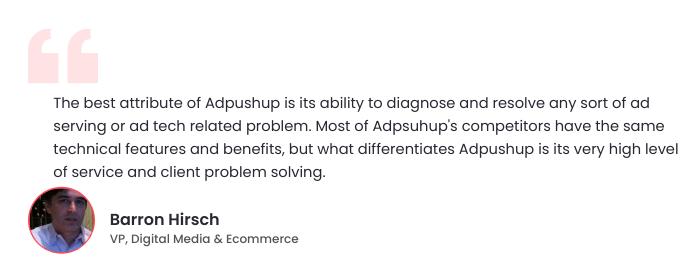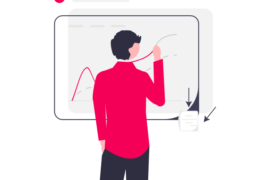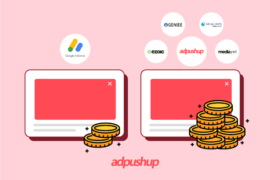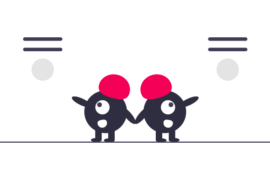A list of 13 field tested tips that will help webmasters and bloggers increase their AdSense earnings based on optimization and continuous testing.
Effectively monetizing a website has always been a tough mountain to climb for webmasters. In this post I’ll share actionable tips, based on experience and best practices, to help publishers make the most out of their Google AdSense account.
First, I’ll start with a quick summary on what are the bare essentials you need to optimize for increased revenue.
The 5 website essentials you need before optimizing for increase in AdSense earnings
Other than being free-to-use, user friendly, and giving users the lion’s share of the revenue (68%) – what else do you need to make more money with AdSense?
1. A high quality website
Publishing content which does not blare AdSense Policy sirens is not enough. Your site needs to be high quality along with publishing high quality content. As a business necessity, Google is answerable to its advertisers to not show high performing ads on the wrong sites. They have updated their policies and conditions to ensure quality control.
2. Displaying brilliant content
Google prefers websites with rich and varied content. The content itself can be text, images and/or videos. The only condition being that they should not be in violation of the AdSense content policies.
Experts and best practices suggest that including some text is advisable because then the AdSense crawlers can accurately interpret what your website is about. Websites that publish articles, case studies and how-to guides generally see favorable response from AdSense.
3. Having sizable traffic
The go-to method to generate online income is perhaps (and many agree with me) AdSense. The higher the amount of visitors on your website will increase the odds of your CTR/EPC (click through rate/earnings per click).
If you receive traffic that primarily comprises of your target audience then it would help in increasing the overall website quality in the eyes of Google.
Therefore, higher quality traffic = more money.
4. With the right Keywords
I’m sure you’ve heard this over and over again the importance of keyword research and SEO and that is because it actually is.
So ‘quality keywords’ per say are those which 1) are used by the advertisers for their products 2) action keywords. Action keywords encourage people to take action through psychological by using high emotion words.
Also, organic traffic is much more valued than paid because it emanates from the target audience.
5. Don’t go for a ‘made for AdSense’ (MFA) website, instead make it purposeful
If your website wants to build a reputation in its target niche then stay away from purposing it to increase AdSense earnings only. Trust me, it will not make you money and neither will it generate traffic. Building a website from the ground up, requires patience, perseverance and quality content. The more you provide value, the more visitors it will attract; thereby increasing the odds of generating more revenue.
How to increase your AdSense revenue?
- Basic Ad unit knowledge
You should ideally structure your html such that the ads with the highest CTR, on an average scale, should load first. This can be accomplished with the use of the ‘<div>’ tags and some CSS. This small change makes sense when you have 2 to 3 ads on your website (AdSense allows a maximum of only 3 ads on a single page). The rationale for this is that AdSense should serve the high performing ads first. So basically, you’re optimizing the system to increase your odds of generating additional revenue.
- Efficient Positioning
It is advisable to give a thought on how to strategically locate your ads on your pages because advertisements do perform differently subject to their location. This is one of the easier ways to ensure that your ads generate more CTR (therefore, your income) while the traffic on your website is constant. Why are we measuring it when the traffic is constant? So that there are no data forecasting anomalies of ads performing very well on a day and then a slump occurs the next day.
Positioning is all about experience in running AdSense on your website, best-practices and finally continuous testing. Below is an example of the various ways in which you can place your ads to increase visibility –
Along with desktop, remember that ad units performance based on a responsive design is equally crucial. A website equipped to handle responsive design will be able to effectively adjust the change in ad unit size based on the user’s screen size. Another benefit of a responsive design is that it adds on to user experience. It helps in decreasing the site’s load time and will create a richer feel for viewers across multiple mobile devices.
Here is a link that will teach you more about how to implement responsive design ads on AdSense. - Traffic or no traffic – Optimize your ads
We’ve discussed above that more traffic means greater odds of increasing your revenue. But don’t make the mistake of taking this for granted. While traffic does play a sizable role in income generation, publishers are still not fully appreciating the power of optimization – testing to boost CTR.
Ad revenue can and should be optimized even if the traffic on your webpage is constant. Same quality and same quantity. So we will deter from focusing on increasing website traffic through the use of on-page optimization of content layout.
To increase CTR during regular traffic requires you to make a few small changes. Go on the web and read about best practices and take the time out to make a plan on slowly making small changes and see their effect on the clicks. The important thing is to make one change at a time so that you can track the success rate correctly. - Play around with ad sizes
Performance of ads is significantly affected based on the size of the units. Best practices state that wider ads have a tendency to out perform taller ads. The live-demo video below, from the Google AdSense team, shows that replacing a 120×600 Skyscraper with a 160×600 Wide Skyscraper and replacing a 468×60 Banner by a 300×250 Medium Rectangle resulted in a 109% increase in AdSense earnings.
This is what optimization can do for you. Imagine the amount of time a webmaster would need to soost their revenue in such a percentage without changing their traffic numbers whereas, these 2 small tweaks have the capacity to double their AdSense revenue. Ads shouldn’t be so huge that they overshadow the content on a website or so small that they don’t have an effect on the user.
It is critical to test different ads sizes in different locations. This combination of multiple choices which might yield the best results, is an example of “multi-armed bandit” problem. What the webmaster doesn’t have in his control is ‘constant change’. An ad variation that is performing well today will not necessarily perform the same tomorrow or a week later which is why we need to A/B test ads and trust continuous optimization.
If you’re worried about getting into so much detail then just keep in mind that you should be positioning ads on your website to complement your content, not over power it. - The Ad unit’s design
For text ads, choose colors that match the ones on your site. I’ve had my own share of successfully running experiments and conclusively say that colors have a huge impact on the CTR. When I asked a few webmasters (some big names that get close to 850,000+ pageviews in a single day) about their testing the text ad colors, all of them informed me that they they had seen nothing short of insane boosts in CTR. In fact, my colleague ran a design test on one of his publisher friend’s website and saw a 75% increase in clicks for that particular ad unit using one of the variations below (in comparison to the original/control) –

- A/B Testing Ad variations will get you results
A/B tests conducted on the basis of these three parameters – location, size, design – give the most conclusive reports on what is working and what is not. Start by picking a few variations and dividing your traffic in between them, ensuring that each variation is not served to a visitor more than once. Similarly, choose variations based on size and then test them too. You can manually carry out these tests or automate them by using our advanced A/B testing Ad revenue optimization tool.
- Test Test Test then again Test
The defining element behind optimization and testing is that they are ‘continuous’. It is a never ending process. It is the one thing that differentiates successful AdSense users from the not so successful ones. The reason is not difficult to decipher, which is that user experience changes with time and which is why same ad units might not perform what they did weeks or months back.
With continuous measurement, testing and machine learning – when an ad unit stops performing – the system starts identifying a new variation and makes that your default. Based on this default a new set of tests will be kicked off. Therefore to truly increase your AdSense earnings you need to constantly keep on testing (which is what our product automatically does).
Below is a diagram highlighting variations of ad units based on our previously discussed parameters, namely location, size and design –
Such advanced testing is time consuming and a difficult nut to crack given the complicated mathematics of probability that goes into it. Oh and how can I forgot to mention that the sample size is constantly changing so you have to do this continuously too. All this hard-work will eventually help you in uncovering the sweet spot for your AdSense ads. - Look towards Custom Search Bars for help
It’s no shocker that Google AdSense is the most widely known and popular advertising network to monetize your website. Publishers are correct in arguing that more clicks means more revenue but wrong in assuming more traffic means more clicks. To help publishers serve relevant ads to their visitors, Google has allowed websites to add up to two Custom Search Bars per page. This is makes for a more targeted and strategic step towards increasing revenue when visitors use the search bars to find information on the site.
If a website is already doing significantly well then the two Custom Search Bars are an effective way because this makes the visitor feel that their needs come first (ad content based on their search results). - Make use of ‘Calls to Action’
Strategically placing ad units near large or prominent call to action buttons is another way to encourage your visitors to click on your ads. However, it is critical that your ad unit should not “fool” or confuse a visitor. They must be able to easily distinguish between a call to action button and an advertisement near a CTA.
Such a problem can be taken care of by exercising caution while designing ads. They shouldn’t appear closely similar to an important call-to-action. - Content always comes first
Webmasters often wonder if the content on their website can influence the CTR of their ad units. There isn’t any research to prove that their is a direct correlation but industry experts believe, based on their experience, that a connection is there. I’ll try to put some light on this with these 2 contrasting examples –
In this article, SEOChat founder Jim Boykin reflects that when visitors find your “content sufficient, good and satisfactory”, their engagement on the website will increase which will lead to a lower CTR. However, on the contrary, if you place an ad unit right at the end of a 2500+ article that is well researched, written, relevant and which a visitor has read from word to word; is it much more likelier that a visitor will click on it then?
I’ll leave you to be the judge of that. Or better yet – test it! - Filter Out Irrelevant Ads
Your CTR will increase if your ads are relevant to the audience along with being targeted. Therefore, the next time you see an irrelevant ad unit (see image below) on your webpage, use your AdSense control panel to remove the advertisers/domains serving such ads.
- Try other Ad networks too
While Google AdSense might or is the most popular and widely used ad network, it necessarily is not the best for every website’s audience. In other words, webmasters need to work out which Ad networks serve what and use those that are directly relevant to their niche or target audience. This could mean looking outside the box and testing your vertical for a specific ad network. This could even mean looking towards Affiliate Networks or CPA. While going through forums I have seen publishers share stories where they made more money in commissions from ClickBank and Amazon than AdSense.
By putting in the effort to really nail down an Ad network that will deliver targeted ads to your visitors, you can maximize your revenue quite quickly and consistently. - Lastly, the Policies
Google is known to be notorious for banning publishers from AdSense with not much reason to investigate and rectify the fault. Open any SEO or internet marketing forum and you will see a large majority of webmasters sharing their experience of being banned by Google. Make sure you’re not one of them. Read the policies.
If anyone has any more useful tips to share then do share them in the comments!
Key Take Aways
- Effectively monetizing a website with Google AdSense can be tough. In this post I’ll share actionable tips to help you.
- Google updates its policies to ensure quality control and to prevent high performing ads from being shown on the wrong sites.
- AdSense is perhaps the go-to method to generate online income. Higher quality traffic = more money.
- To increase CTR during regular traffic, make a few small changes and track the success rate correctly.
- There isn’t any research to prove that the content on your website can influence the CTR of your ad units.

FAQs
AdSense payments are made monthly. During the course of a month, you accrue estimated earnings, and then at the beginning of the following month, your final earnings are posted to your Payments account.
There are several great advantages to Google AdSense:
i. It’s free to join.
ii. New websites and blogs are eligible, so you can monetize them right away.
iii. You can customize several ad options to fit the look and feel of your site
AdSense generally gives publishers 68%, or 51% when they use it for reach. Publishers can earn from $0.20 to $15 per click, depending on the niche.

Shubham is a digital marketer with rich experience working in the advertisement technology industry. He has vast experience in the programmatic industry, driving business strategy and scaling functions including but not limited to growth and marketing, Operations, process optimization, and Sales.







